By Jeffrey A. Rendall, Photos by Chuck Rendall
SIMI VALLEY, CA – Whenever I’m asked why southern California is such a popular place to live, I always answer, ‘it’s got a little bit of everything – beaches, warm weather, great entertainment, great food, and it’s also close to the mountains or even the desert, if that’s what you like to do.’
What I tend to leave out is the other side of the story, namely the potential for great natural disasters that sometimes envelope the region. Everyone knows about earthquakes and California, but how about fires and floods?
For those looking for a quick study on the ‘natural’ challenges that living in southern California presents, delve into the story of Lost Canyons Golf Club in Simi Valley (about an hour northwest of Los Angeles), which typifies how tough it can be to ‘survive’ in a region where the potential for wildfires is ever-present a good portion of every year – and monsoon-like rains also show up from time to time.
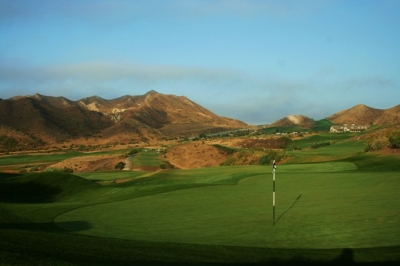 |
| Looking back from the green of Sky Course's par four 1st hole. |
It’s safe to say, the Pete Dye designed Lost Canyons courses (Sky and Shadow) have been through a lot in their brief history (opened in 2001), having ‘lived’ through a wildfire that blew through the property in 2003 and floods late the next year – and that’s not even talking about the struggles it took to build the club in the first place.
Jeff Potts was Dye’s Lead Designer at Lost Canyons, and he says it was a monumental task to just get the courses built. Potts says the story begins in the early nineties: “The land that eventually became known as Lost Canyons was owned by a Japanese corporation and controlled by a Japanese family, Mr. and Mrs. Hirasawa – and they wanted to build a 36-hole golf complex within a major housing development.”
Potts continues, “Early on, the late Roy Dye (Pete’s brother) was involved with the project – and I was working for Perry Dye (Pete’s oldest son) at the time and had just come back from two years building courses in Japan. We’d essentially been cutting the tops off mountains and filling in valleys to create enough semi-flat space to build golf holes – which is basically what was being proposed at Lost Canyons (known as Big Sky at the time) – the only difference being they wanted to add a residential component.”
Potts explained that Roy Dye’s specific involvement included the portion of the land that is now the Shadow Course – and that because of the presence of a Japanese client and Perry’s prior experience in Japan (and because Roy’s health was beginning to suffer), Roy asked Perry to take a look at the project.
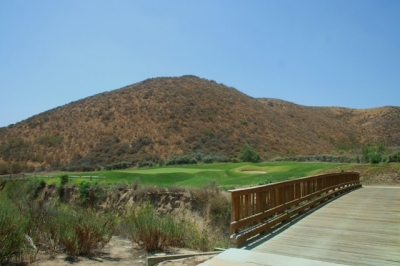 |
| There's no way there except through the air on the par four 8th hole (Shadow) - and you'll need to take this bridge to reach the green as well. |
Perry Dye then sent Luke Dye (Roy’s youngest son) and Potts out to see the land and meet with the Japanese contractor, where Potts says he was awed by the prospects. “It’s not an overstatement to say that the plans were grandiose – hundreds of homes, an artificial stream running from the top to the bottom of the canyon, a major clubhouse, etc… all of which would have amounted to a major amount of earthwork, as much as eleven million yards.”
Circumstances then set the project back, as both Roy Dye and Mr. Hirasawa passed away and the plans then descended to Mrs. Hirasawa to decide on how to move forward.
Mrs. Hirasawa was then introduced to Gerry Barton of Landmark Golf, which had done extensive work in the Palm Springs area and had the expertise to deal with a ‘vision’ of this size – but Barton said he wouldn’t be interested in the project under the current master plan, but would potentially do it if the master plan was adjusted.
Up to that time, Pete Dye had done practically every golf course in Landmark’s portfolio, so it made sense to bring him onboard – and a new master plan was developed with 36 holes of golf and a much scaled-back housing community with Pete Dye as the designer.
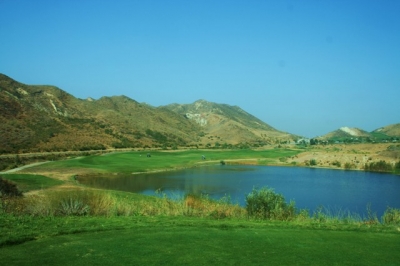 |
| This lake on Sky's par four 9th hole is by far the largest water feature at Lost Canyons. |
Barton then put together the financial partners, and Lost Canyons was born.
Hard as it is to believe, that’s only the beginning of the story. Potts said the design team was very much impressed with the scenic mountainous terrain (especially with it being so close to metropolitan Los Angeles), but it also presented some formidable challenges on how to make it suitable to host a couple upscale golf courses.
“It looked like something right out of TV Westerns,” Potts elaborated. “Shows such as Little House on the Prairie and Bonanza were filmed nearby (Ed note: the sets for the shows are NOT on or immediately adjacent to the property). Clearly there were many spectacular golf holes out there, but could we connect all the dots to get the type of routing Pete wanted?”
And then there was the sometimes arduous California environmental and governmental approval process to deal with – though Potts says that part of the construction went fairly smoothly by Golden State standards.
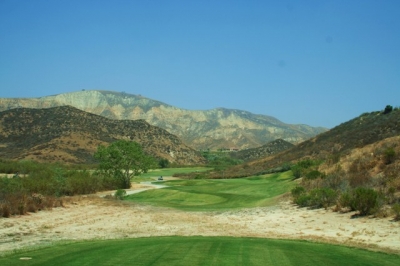 |
| Shadow's par three 11th hole offers long range mountain views that take your breath away. |
The largest challenge was routing, and just finding enough room for the club essentials (clubhouse, range, parking lot, plus starting and finishing holes for two golf courses near the main area) proved to be quite a task, since the property’s one large ‘flat’ area (the only suitable location) was located about one mile from the nearest access road.
The Lost Canyons property also contains a large portion of Coastal Sage Scrub habitat, which is the nesting home for the protected Black Tailed Gnatcatcher – so there were strict limitations on when and how much of this type of land could be cleared, which was a particular problem on the Shadow Course (and it shows up in the course’s relatively narrow playing areas).
That wasn’t all. “Another challenge was the sheer ‘scale’ of the environment,” Potts lectured. “Because the surrounding mountains are so large and steep this tends to make the eye underestimate the severity of the flatter areas of the project. What looked to the naked eye like a natural area for a fairway with say a five or ten-percent cross-slope would invariably turn out to be more like 20 or 30% when studied on the topo map.”
“When my first grading plan came in at about one million yards per course, many people were shocked to see that some of the more natural ‘looking’ areas required so much dirt work to make them playable,” Potts added.
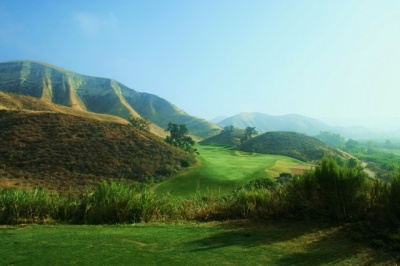 |
| Sky's par five 4th hole has a narrow looking tee shot, but there's plenty of room to drive the ball if you know where to aim. |
The slopes definitely played havoc with Dye’s ever-present desire to create a walk-able golf course. Potts says their very outside limit for uphill holes is 8% (grade) which is still about two-percent beyond strict walking comfort, in his estimation. It’s extremely difficult to incorporate walking when you have to play downhill at 10-15% on one hole, and then back up at 6% the next.
Once they settled on a routing, the most troublesome issue was the underlying geology. Again, Potts gets technical: “Cut slopes generally could not exceed 3:1 for fear of slippage from above, and in many cases, the toe of a slope to open up a hole visually or cutting a saddle down to play through would require grading impacts several hundred feet up the slope. For many reasons this was just not practical, thus we ended up with several blind or semi-blind shots (Sky #s 4, 11, 14 and 18, and Shadow #s 3, 5, 7, 13 and 18).”
Playability was a concern in other ways as well. Potts said Dye wanted to fill (or clear) in several places on the site that would have eliminated forced carries, but it was prohibited because of the restrictions described above – and it was a major source of frustration for Dye, who always likes to give high-handicappers a break off the tee whenever he can.
There are also two major washes – or dry creeks – that run through the property that couldn’t be touched, which resulted in some lengthy bridges needed to cross them (more on this later).
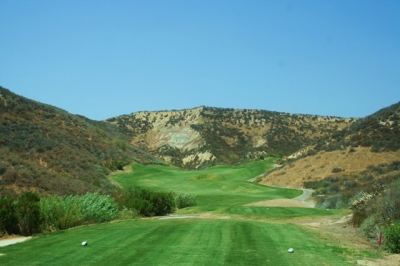 |
| It's hard to tell from this view, but Shadow's short par four 13th hole doglegs sharply right at the tee shot landing area. |
Perhaps because of the difficulties involved with building the courses, a golf course contractor – Landscapes Unlimited – was used for construction. “Typically Pete brings in a handful of ‘Pete’ guys and they run the project for the owner who generally acted as some sort of general contractor,” Potts explained.
“But in Lost Canyons’ case, we’d had a good relationship with Landscapes Unlimited (which had worked with Landmark before on several occasions) and it made sense to bring them in to a project with tough terrain where we were trying to build 36 holes in twelve months and needed the manpower and equipment that a larger contractor provides,” Potts remembered.
Lost Canyons had another thing going for it during the construction phase, namely the input of PGA Tour star Fred Couples, who is listed as a ‘consultant’ on the courses. Potts said Couples did make several visits to the site, though his role was mostly sharing a Tour player’s perspective of what was being created.
“I think Fred has been very upfront about his involvement at Lost Canyons,” Potts said. “He didn’t really have much design influence unless you consider the fact that he’s a Tour player and Pete is always trying to figure out how to get those guys without messing too much with the paying customer. Fred was more concerned with quality control, image of the project, etc., and I think his visits involved getting comfortable with what we were doing.”
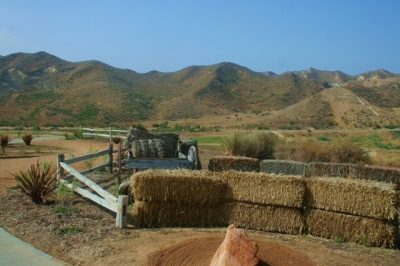 |
| The old west theme is never far away at Lost Canyons. |
As interesting as Lost Canyons’ background has proven to be, opening up the golf courses has proven to be only part of the story. As alluded to above, fires and floods figure prominently in the Lost Canyons legacy – and it’s as much a tale of survival as you’ll find at any golf facility.
Lost Canyons’ Director of Golf is Jay Colliatie, and he’s seen the property though some pretty troubling times. “The fires came towards the end of 2003, and pretty much devastated a large part of southern California.”
He continues, “We tracked the fire and were fortunate enough to put our sprinkler system on – and we store our own water, so we didn’t take away from the firefighters’ efforts by any stretch. As a result, the greens and fairways came through okay – the golf course itself was unscathed. But everything around it, all the hillsides that you see for miles and miles around were devastated.”
It’s somewhat sad to note that the fire claimed most if not all of the movie/TV production sets in the surrounding areas, including all the remaining buildings from ‘Little House on the Prairie.’ Even today (2010), the scars from the fire can still be seen in the hills surrounding the courses.
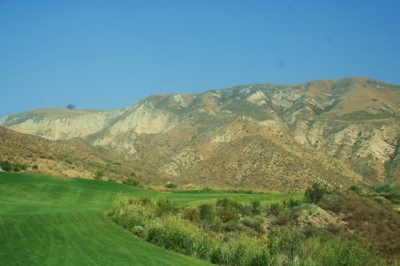 |
| Looking towards the green of Sky's par four 11th hole, it's hard to believe that you're just a short distance from a huge population center. |
The day after the fire revealed that all the wooden bridges on both courses had been burnt to the ground and had fallen into the ditches – and the ditches are very wide. The lack of bridging made it impossible to play the courses as they were laid out – but somehow, Colliatie said they were able to string together a collaboration of eighteen holes from both courses to keep the facility open while repairs were being undertaken on the rest of the infrastructure.
It took eight months for the repairs to be completed, and for both courses to reopen – which was late in 2004.
But Mother Nature was far from finished with Lost Canyons.
“The floods came in late 2004, not really that long after we were back up at full strength,” Colliatie remembered. “Because of the bare hillsides, there was nothing to stop the water flow coming off the mountains – and it took out the same bridges we’d just built, taking out the huge footings and everything. And the ditches themselves just got wider – we had to rebuild the bridges all over again.”
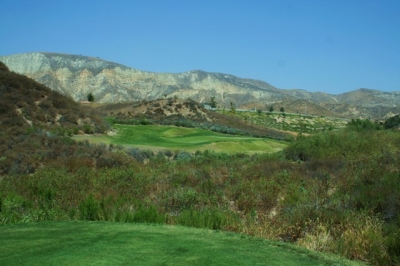 |
| There's very little room to miss on Shadow's tough par three 16th hole. |
Colliatie said it didn’t take quite as long to rebuild this time around, but it was well into 2005 before they were back up again. It was worse than the fires in one sense – the water washed a lot of soil onto the fairways and wiped out a great many of the fairway bunkers.
“We’ve gone forward since those days, but it’s been difficult to say the least. The impact of the economy on golf from that time until now – certainly the past couple years have been pretty tough on golf,” Colliatie added.
With all the turmoil, you’d think it would change the nature of the golf courses, but Colliatie says the layouts came through virtually unchanged. He said they did make some corrections on the Shadow Course (the Sky is the same as when it opened), but those alterations were due more to trying to soften up a few holes rather than anything mandated by nature.
And despite the two layouts occupying similar topography on adjacent terrain, they really do play differently.
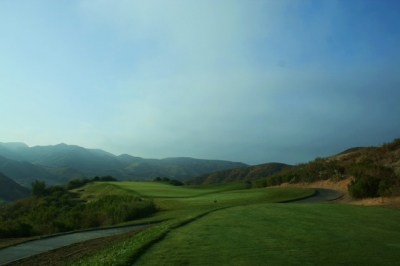 |
| Sky's par three 2nd hole looks like it's been there for a hundred years. |
“The Sky Course was certainly built with the idea of hosting some major events or even the PGA Tour, so it’s more of a championship golf course,” Colliatie explained. “It’s fairly tight in some areas, and then once you get to the greens, you’ve got a lot of undulation. It’s a challenge for the little chip shots, where you’ve got to compete with the slopes in the greens. As far as the Shadow Course, it’s definitely tighter, and requires you to be able to hit the right-to-left shots as well as the other way around.”
Of course, both layouts play much more ‘friendly’ from the proper tee boxes – though Colliatie says players don’t always see it that way. “Today’s golfer, I think they figure the more they paid the further back they’ve got to play – and that’s not going to make for a very good day with the type of golf courses we have.”
Overall, the Sky course seems wider, so it’s probably a bit friendlier to high-handicappers, even if the greens are a little harder to navigate.
The Shadow Course has a number of holes where the playing corridors are somewhat narrow for this type of golf course – and if you’re hitting it a bit offline, you could be in for a long day.
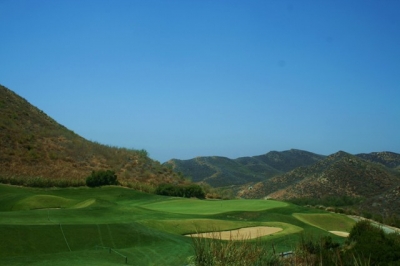 |
| Long is usually the worst bailout option at Lost Canyons, and that's never more true than on the Shadow Course's par four 3rd hole. |
The facility didn’t acquire the nickname ‘Lost ball canyons’ for nothing.
But the brief moments of frustration hardly overshadow the quality of the experience, which is certainly in the top tier of public-access facilities in southern California. Colliatie sums up the experience: “There are no planes flying over, no houses and no hotels, so it kind of gives you a chance to get away from it all – and you’re still only a short distance from L.A.”
And knowing the history of Lost Canyons, you know they’ve worked awful hard to give you that opportunity to escape.
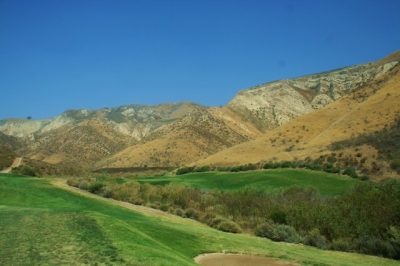 |
| Good placement off the tee is crucial to leave a manageable second shot into Sky's par four 15th hole. |
Details:
3301 Lost Canyons Drive
Simi Valley, CA 93063
Phone: (805) 522-4653
FAX: (805) 522-1389
Website: www.lostcanyons.com
Director of Golf: Jay Colliatie, PGA
Course Architect: Pete Dye, with Fred Couples consulting
Dye’s Lead Designer at Lost Canyons: Jeff Potts
Shadow Course Tees/Yardage/Rating/Slope
Black 7005 75.0/149
Gold 6530 72.4/144
Silver 6055 70.0/136
White 5420 67.1/127
Copper 4795 69.1/125
Sky Course Tees/Yardage/Rating/Slope
Black 7285 75.6/147
Gold 6740 73.3/143
Silver 6225 70.5/136
White 5605 67.8/126
Copper 4885 70.0/120
SKY COURSE – PRIME – TWILIGHT -- SUPER TWI
Tuesday - Thursday $ 75 $ 60 $ 45
Friday $ 85 $ 70 $ 55
Saturday (& Holidays) $ 99 $ 80 $ 65
Sunday $ 90 $ 70 $ 65
Tuesday - Thursday $ 70 $ 50 $ 39
Friday $ 75 $ 60 $ 45
Saturday (& Holidays) $ 90 $ 70 $ 55
Sunday $ 85 $ 60 $ 45
| Related Links | Comments on this article? | |
|
Maryland National Golf Club Hollow Creek Golf Club Rocky Gap Resort PB Dye Golf Club in Ijamsville Whiskey Creek Golf Club |
E-mail Jeff Rendall, Editor: jrendall@golftheunitedstates.com |











